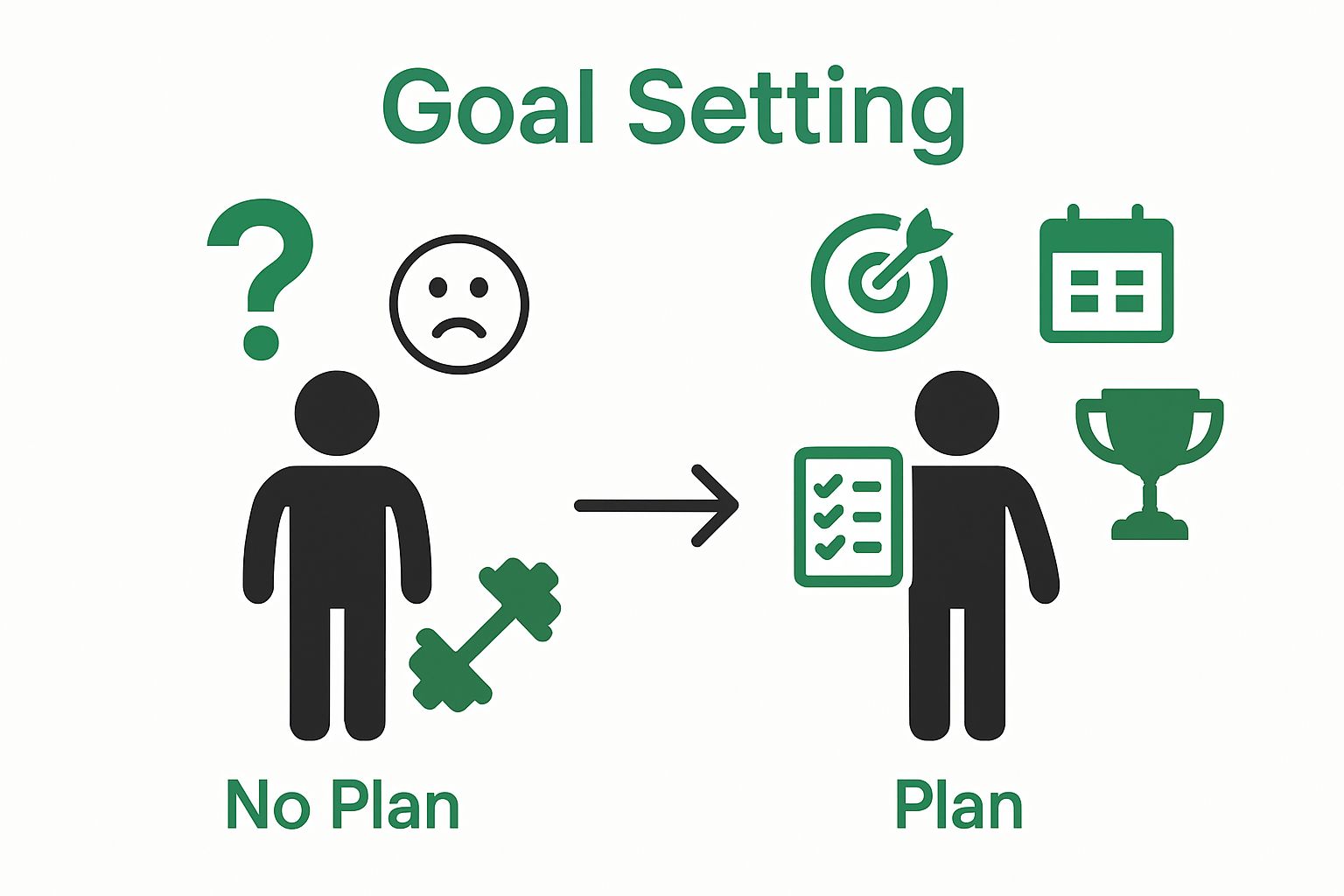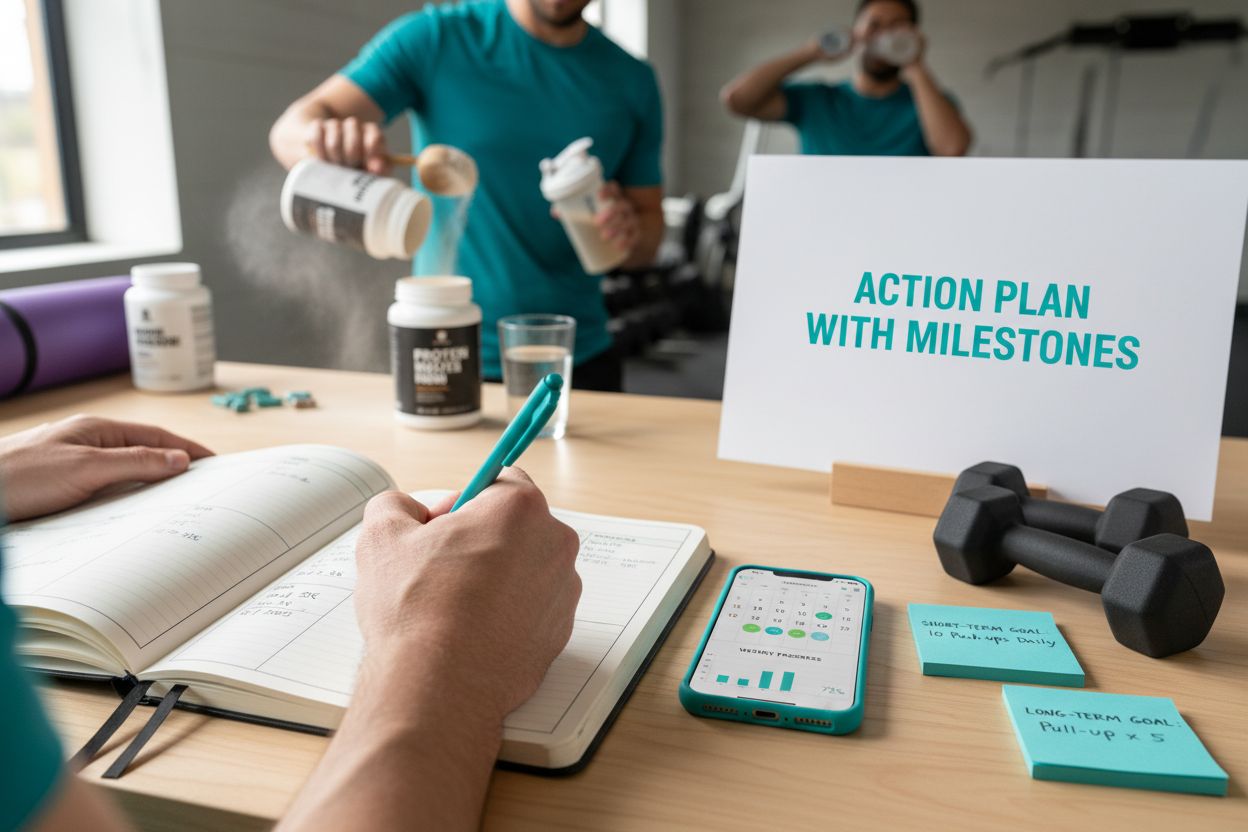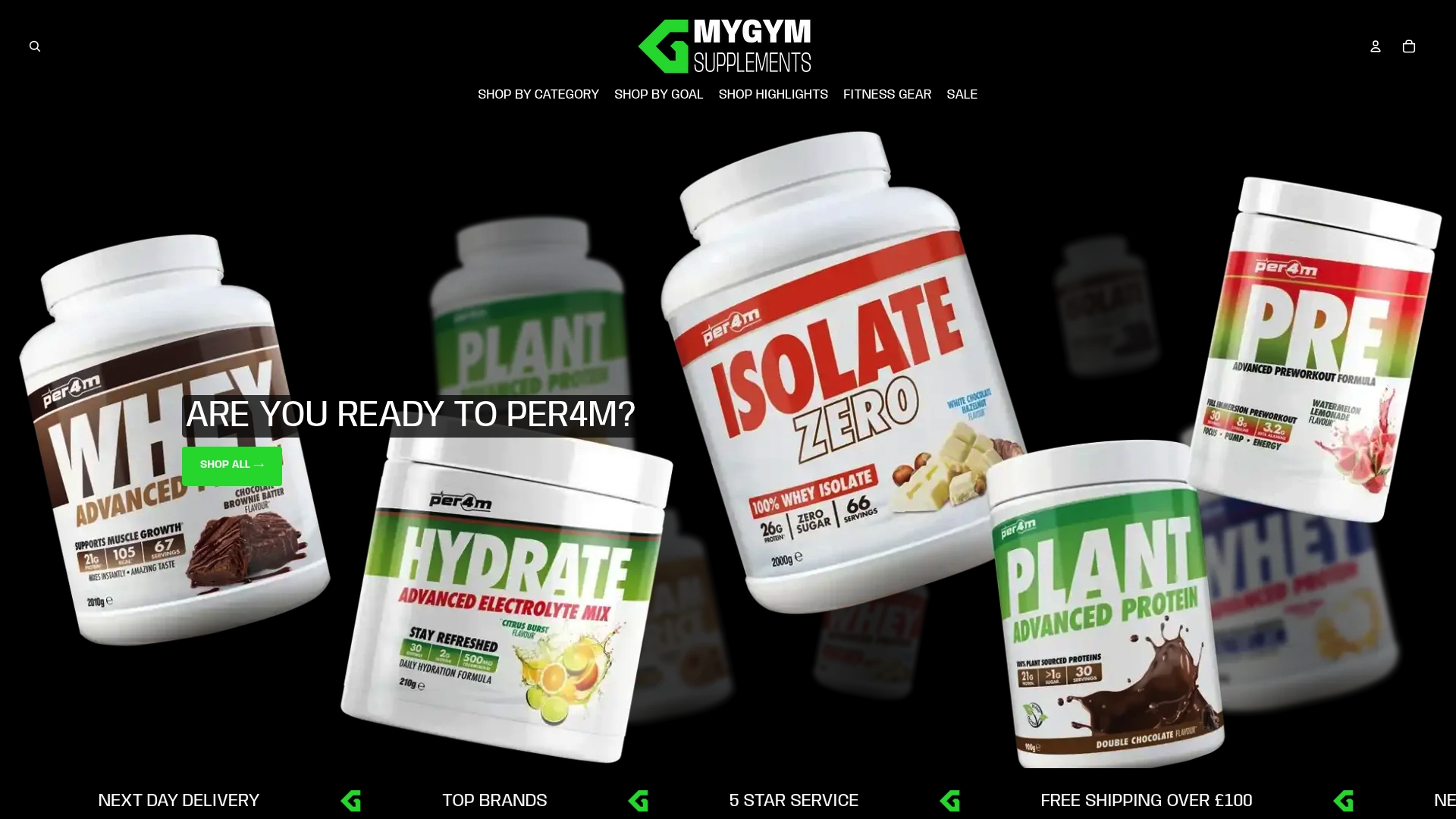Setting fitness goals is more than wishful thinking or jotting down a few targets on paper. People who set specific, measurable goals are up to 42 percent more likely to achieve them than those who do not. Surprising, right? Most assume sheer motivation is enough. The real secret lies in careful planning and continuous adaptation, which often matters more than endless workouts or strict diets.
Table of Contents
- Step 1: Assess Your Current Fitness Level
- Step 2: Define Specific and Measurable Goals
- Step 3: Create a Realistic Timeline for Achievement
- Step 4: Develop an Action Plan With Milestones
- Step 5: Monitor Progress and Adjust Goals as Needed
Quick Summary
| Key Point | Explanation |
|---|---|
| 1. Assess your fitness level first | Conduct a thorough self-evaluation of strength, endurance, flexibility, and body composition to establish your baseline fitness. |
| 2. Set SMART goals | Define Specific, Measurable, Achievable, Relevant, and Time-bound objectives to provide clear targets for your fitness journey. |
| 3. Create a realistic timeline | Develop a structured, flexible timeline that includes gradual progressions and allows for necessary recovery periods. |
| 4. Develop an actionable plan with milestones | Break your goals into smaller milestones, integrating various fitness components to keep your progress measurable and motivating. |
| 5. Monitor and adjust goals | Regularly track your progress and be ready to adjust your goals based on your evolving capabilities and lifestyle factors. |
Step 1: Assess Your Current Fitness Level
Before embarking on any fitness journey, understanding your current physical condition is crucial. This initial assessment provides a baseline from which you can design targeted, achievable goals that match your individual capabilities. Learn more about personal fitness assessment to create a roadmap tailored specifically to your needs.
Begin by conducting a comprehensive self-evaluation across multiple fitness dimensions. Physical fitness is not just about weight or muscle mass, but encompasses strength, cardiovascular endurance, flexibility, and overall mobility. Start with some simple yet revealing tests that will give you an honest snapshot of your current fitness landscape.
First, assess your cardiovascular endurance through a straightforward walking or running test. Time how long you can comfortably walk or jog without feeling completely exhausted. This baseline measurement will help track your progress and determine realistic cardiovascular training goals. Additionally, perform basic strength assessments like push-ups, squats, and planks to understand your current muscular strength and endurance levels.
Next, measure your flexibility by conducting simple stretching evaluations. Can you touch your toes? How far can you reach without discomfort? These tests reveal your current range of motion and potential areas for improvement. Remember, flexibility is not about instant perfection but gradual, consistent enhancement.
Nutritional status and body composition are equally important components of your fitness assessment. Consider tracking key metrics such as body weight, body fat percentage, and basic measurements like waist circumference. These numbers provide objective data points that help you understand your starting point and track future progress more accurately.
For those seeking a more scientific approach, consider consulting a fitness professional who can conduct comprehensive fitness assessments using specialized equipment. They can provide detailed insights into your cardiovascular health, muscular strength, body composition, and potential areas of improvement that might not be immediately apparent through self-testing.
Below is a comparison table outlining different methods for assessing your current fitness level, along with what each method measures and the benefits it offers.
| Assessment Method | What it Measures | Key Benefit |
|---|---|---|
| Walking/Running Test | Cardiovascular endurance | Establishes aerobic fitness baseline |
| Push-Ups/Squats/Planks | Muscular strength and endurance | Gauges upper/lower body capability |
| Flexibility Stretches (e.g. Toe Touch) | Range of motion, flexibility | Identifies areas needing improvement |
| Body Weight Measurement | Overall body mass | Tracks weight-related changes |
| Body Fat % and Waist Circumference | Body composition | Assesses fat distribution and changes |
| Professional Fitness Assessment | Comprehensive physical health, advanced metrics | Provides personalised insights |
Ultimately, this initial assessment is not about judgment but understanding. It serves as a personal roadmap, highlighting your current strengths and identifying areas where targeted training can yield significant improvements. By establishing this baseline, you’re setting the foundation for a strategic, personalized fitness journey that respects your current condition while ambitiously pushing towards your desired outcomes.
Step 2: Define Specific and Measurable Goals
Transitioning from understanding your current fitness level to establishing concrete goals requires precision and strategic thinking. The art of setting fitness goals is not about creating vague aspirations, but crafting targeted, actionable objectives that propel you towards meaningful transformation. Experts in sports psychology consistently emphasize the importance of well-defined goals in achieving sustained fitness success.
Begin by transforming broad desires into specific, quantifiable targets. Instead of stating “I want to get fit,” articulate precisely what fitness means to you. Are you aiming to lose 10 kilograms of body fat? Build 5 kilograms of lean muscle mass? Improve your running endurance to complete a 10-kilometre race? Specificity is your strategic advantage.

Utilise the SMART goal framework as your primary goal-setting methodology. Each goal should be Specific, Measurable, Achievable, Relevant, and Time-bound. For instance, rather than a nebulous objective like “get stronger,” craft a precise goal such as “increase my bench press by 15 kilograms within four months” or “complete 12 uninterrupted pull-ups by September”.
Consider creating both short-term and long-term goals that interconnect and build upon each other. Short-term goals act as stepping stones, providing motivation and measuring progress towards your ultimate fitness vision. A short-term goal might involve increasing your weekly workout frequency, while a long-term goal could focus on transforming your overall body composition or participating in a specific athletic event.
Documentation becomes crucial in this process. Maintain a detailed fitness journal or digital tracker where you record your objectives, current measurements, and periodic progress assessments. This practice not only helps you stay accountable but provides tangible evidence of your advancement. Tracking becomes your personal motivation engine, offering clear visual representation of your journey.
Remember that goal setting is not a rigid, unchangeable contract but a dynamic process. Be prepared to reassess and adjust your objectives as you progress. Your initial goals might need refinement based on your body’s response, lifestyle changes, or newfound capabilities. Flexibility combined with commitment ensures sustained progress.
Finally, ensure your goals align with your broader lifestyle and personal motivations. A fitness goal disconnected from your genuine interests will struggle to maintain momentum. Whether driven by health improvements, athletic performance, aesthetic transformations, or mental wellness, your goals must resonate with your deeper personal narrative. By anchoring your objectives in authentic motivation, you create a powerful, intrinsic drive that transcends mere physical achievements.
Step 3: Create a Realistic Timeline for Achievement
Crafting a realistic timeline transforms ambitious fitness goals from abstract concepts into actionable strategies. Fitness progression guidelines from the NHS emphasize the critical importance of understanding your body’s adaptation capabilities when planning your fitness journey.
Begin by breaking down your overarching fitness objectives into smaller, manageable milestones. Sustainable progression is key to maintaining motivation and preventing burnout or potential injury. Consider your initial fitness assessment and recognize that meaningful transformation occurs incrementally, not overnight. A well-structured timeline accounts for natural physiological adaptation rates, personal commitments, and potential life disruptions.
Establish a phased approach that allows for gradual intensity increases. If your goal involves strength training, for example, plan incremental weight progressions that challenge your muscles without overwhelming them. Typically, a conservative approach might involve increasing weights by 2-5% every two to three weeks, allowing your body sufficient recovery and adaptation time.
Integrate recovery periods strategically within your timeline. Rest is not a sign of weakness but a critical component of fitness progression. Your body requires adequate recuperation to repair muscle tissues, prevent burnout, and optimize performance. Design your timeline to include deload weeks or reduced-intensity periods approximately every 6-8 weeks, where you maintain activity but reduce overall training stress.
Consider potential external factors that might impact your fitness journey. Work schedules, family commitments, seasonal variations, and personal energy levels can significantly influence your ability to maintain consistent progress. Build flexibility into your timeline, creating contingency plans that allow for minor setbacks without completely derailing your overall objectives.
Utilise digital tracking tools or traditional fitness journals to monitor your progress against the established timeline. These resources provide visual confirmation of your advancement and help identify areas requiring adjustment. A comprehensive tracking system might include metrics such as workout frequencies, performance improvements, body composition changes, and subjective energy levels.
Remember that a realistic timeline is a dynamic document, not a rigid contract. Be prepared to make informed modifications based on your body’s response and personal circumstances. Periodic reassessment every 4-6 weeks allows you to celebrate achievements, recalibrate strategies, and maintain momentum. Your timeline should feel like a supportive framework that guides and motivates you, rather than a restrictive set of demands.
Ultimately, the most effective timeline balances ambitious goals with compassionate self-understanding. Recognize that fitness is a lifelong journey of continuous improvement, not a destination to be reached through punishing, unsustainable efforts.
Step 4: Develop an Action Plan with Milestones
Transitioning from goal setting to practical implementation requires a strategic, detailed action plan that transforms aspirational fitness objectives into tangible daily practices. Sports performance research consistently demonstrates that structured, well-designed action plans significantly increase the likelihood of achieving fitness goals.
Comprehensive action planning begins with granular breakdown of your overarching fitness objectives. Each major goal needs to be dissected into smaller, progressive milestones that create a clear pathway towards ultimate achievement. These milestones serve as motivational checkpoints, providing regular opportunities to acknowledge progress and recalibrate strategies if needed.
Consider developing a multidimensional action plan that addresses various fitness components simultaneously. This might involve creating specific protocols for strength training, cardiovascular endurance, nutritional intake, and recovery strategies. Your plan should interlink these elements, recognizing that holistic fitness requires balanced, integrated approaches.
Design your milestone tracking system with precision and clarity. Quantifiable markers are crucial for maintaining motivation and measuring advancement. For instance, if your long-term goal involves increasing muscle mass, your milestone markers might include specific strength progression metrics, body composition changes, and performance benchmarks. Incorporate both objective measurements like weight lifted or distance run, and subjective assessments such as energy levels and overall well-being.
Implement a robust documentation strategy to support your action plan. Utilize digital fitness tracking applications or a dedicated fitness journal to record your progress meticulously. This documentation serves multiple purposes: it provides accountability, helps identify patterns of success and potential obstacles, and creates a tangible record of your transformation journey.
Recognize that flexibility is an essential component of effective action planning. While structure is important, your plan should accommodate unexpected life challenges, potential physical limitations, and personal energy fluctuations. Build contingency strategies that allow for modifications without completely abandoning your core objectives.
Establish a consistent review and adjustment mechanism for your action plan. Schedule periodic assessments every 4-6 weeks to evaluate milestone achievements, identify areas requiring additional focus, and celebrate your progress. These review sessions are not about self-criticism but strategic refinement, ensuring your fitness journey remains dynamic and responsive to your evolving capabilities.
Ultimately, an exceptional action plan transcends mere technical documentation. It becomes a personal roadmap that reflects your commitment, integrates your unique physiological characteristics, and transforms fitness goals from abstract concepts into lived experiences. By creating a comprehensive, adaptable plan with clear milestones, you establish a powerful framework for sustained personal transformation.

Step 5: Monitor Progress and Adjust Goals as Needed
Progressively tracking your fitness journey transforms data into actionable insights that drive continuous improvement. Scientific research in exercise physiology emphasizes that systematic progress monitoring is crucial for sustained fitness success and personal motivation.
Effective progress monitoring goes beyond simple measurements, requiring a holistic approach that captures both quantitative and qualitative data. Implement a comprehensive tracking system that evaluates multiple dimensions of your fitness progression. This means recording not just physical metrics like weight, body fat percentage, and strength levels, but also subjective indicators such as energy levels, mood, sleep quality, and overall well-being.
Develop a consistent assessment routine that allows for meaningful comparison over time. Schedule regular check-ins every 4-6 weeks where you conduct thorough evaluations of your fitness goals. These assessments should involve detailed measurements, performance tests, and personal reflection. Utilize digital fitness tracking tools or maintain a dedicated fitness journal to document your journey systematically, creating a tangible record of your transformation.
Recognize that goal adjustment is not a sign of failure but a sophisticated strategy of adaptive progression. As you gain more understanding of your body’s responses and capabilities, be prepared to recalibrate your objectives. Some goals might require acceleration, while others may need more gradual approach. The key is maintaining a flexible mindset that views your fitness plan as a dynamic, evolving strategy rather than a rigid, unchangeable blueprint.
Pay close attention to your body’s signals during this monitoring process. Physical performance indicators, recovery rates, and potential signs of overtraining or plateau are critical information points. If you consistently struggle to meet certain milestones or experience persistent fatigue, this might indicate a need to modify your training intensity, nutritional strategy, or recovery protocols.
Integrate qualitative self-assessment techniques alongside quantitative measurements. Reflect on your motivation levels, psychological engagement with fitness activities, and overall sense of progress. Sometimes, the most significant transformations are not immediately visible in numerical data but manifest in increased confidence, improved mental resilience, and enhanced lifestyle quality.
Establish a constructive framework for goal reassessment that balances ambition with realistic expectations. When adjusting goals, consider three primary factors: your current physical capabilities, lifestyle constraints, and long-term health objectives. A successful fitness journey is not about perfection but consistent, intelligent adaptation.
Ultimately, progress monitoring is an art of balanced observation and compassionate self-understanding. It requires patience, honesty, and a commitment to continuous learning about your body’s unique responses. By approaching your fitness goals with this nuanced perspective, you transform mere exercise into a profound journey of personal growth and self-discovery.
The following table provides a checklist of key activities for monitoring progress and adjusting fitness goals, to help ensure visibility and timely action throughout your fitness journey.
| Action | Frequency | Purpose |
|---|---|---|
| Record physical metrics (weight, strength) | Every 4-6 weeks | Quantify objective progress |
| Evaluate performance tests | Every 4-6 weeks | Assess improvements in specific skills |
| Reflect on energy, mood, and motivation | Every 4-6 weeks | Monitor qualitative well-being |
| Adjust goals based on outcomes | As needed | Ensure goals remain relevant and challenging |
| Schedule regular goal review sessions | Every 4-6 weeks | Maintain accountability and focus |
Take Your Fitness Goals Further With Personalised Nutrition
You have just learned how crucial it is to assess your starting point, set SMART goals, and continuously monitor progress to reach your best results. But what happens when your motivation dips, your energy drops, or you struggle to recover between sessions? Many people find that good planning alone does not always guarantee progress. Nutrition plays a vital role in turning your fitness plans into real-life achievements. If you already know what you want to achieve—like building muscle, losing weight, or boosting recovery—targeted nutritional support can make every goal more reachable.

Discover the difference the right supplements can make. Visit MyGymSupplements.shop to find carefully selected protein blends, performance enhancers, and recovery aids. Shop by goal or category to match your chosen fitness priorities. Do not just set your goals—give your body everything it needs to conquer them. Explore our best sellers or browse health and wellbeing supplements now for momentum you can feel. Start optimising your plan today and see the results faster from your very next session.
Frequently Asked Questions
How do I assess my current fitness level before setting goals?
Begin by evaluating your strength, cardiovascular endurance, flexibility, and mobility through simple tests like walking or running for time, push-ups, and flexibility stretches. Document your results to establish a clear baseline that will inform your goal setting.
What makes a fitness goal specific and measurable?
A specific fitness goal clearly defines what you want to achieve, such as “lose 5 kilograms in three months” or “run 5 kilometres without stopping”. Ensure that you can track your progress with quantifiable metrics to stay motivated.
How can I create a realistic timeline for my fitness goals?
Break down your larger goals into smaller milestones with specific deadlines, such as increasing your workout frequency over the next month. Aim to review your progress every 4-6 weeks to make necessary adjustments to your timeline.
What should I include in my action plan for fitness goals?
Your action plan should detail step-by-step activities for achieving your goals, including workout schedules, nutrition plans, and recovery days. Use quantifiable milestones and keep your plan flexible to adapt to any life changes that arise.
How do I monitor my progress and know when to adjust my goals?
Monitor your progress by tracking both quantitative metrics (like weight and strength levels) and qualitative factors (such as energy and mood) every 4-6 weeks. If you find you’re consistently hitting milestones too easily or struggling, adjust your goals accordingly to maintain a challenging yet achievable pace.
What is the SMART framework for setting fitness goals?
The SMART framework stands for Specific, Measurable, Achievable, Relevant, and Time-bound. For example, instead of saying “I want to get fit,” you could say “I want to increase my bench press by 10 kilograms within the next three months.”



0 comments